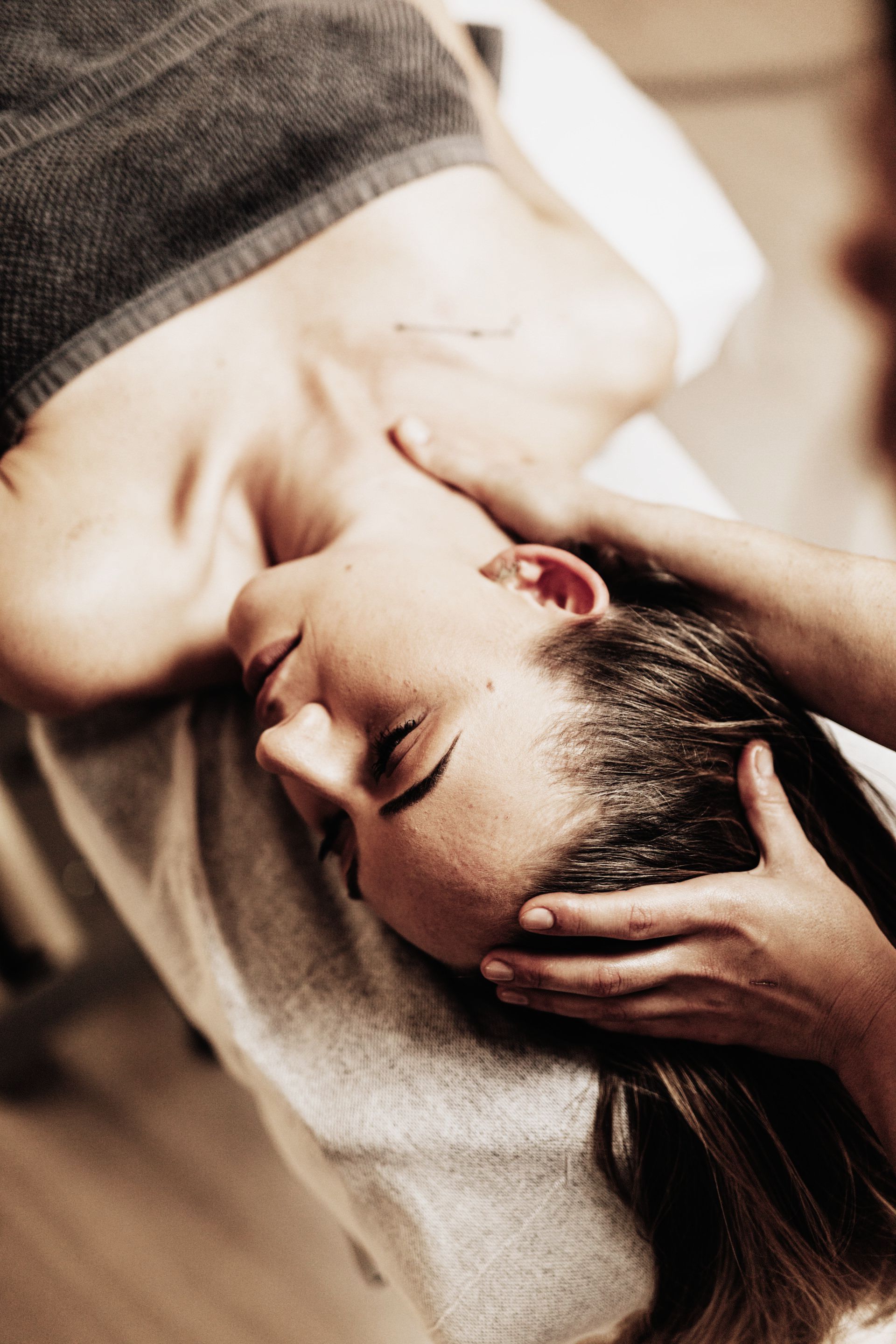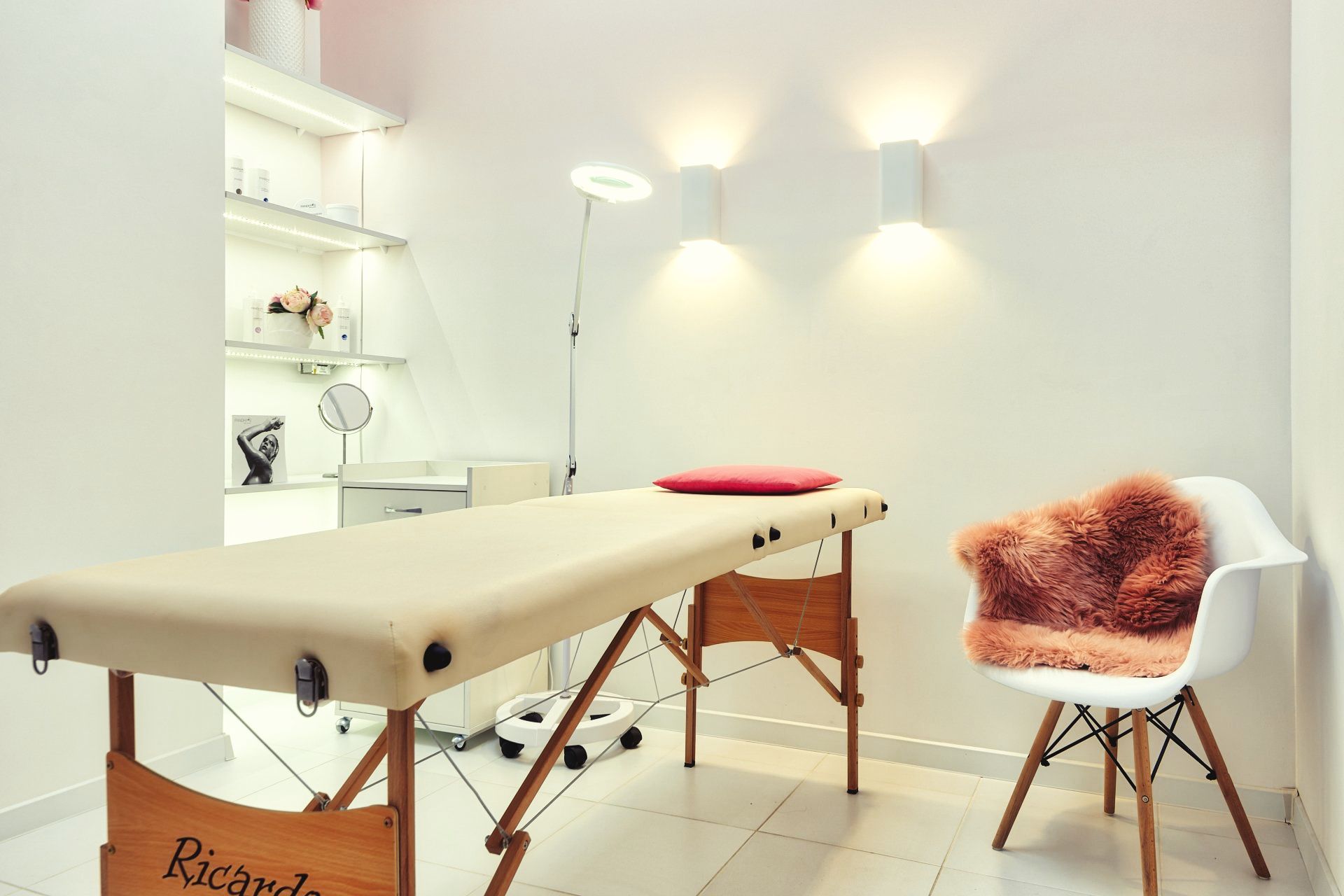Craniosacral bodywork
Application style mechanical-biodynamic
Craniosacrale Anwendung
| ✓gesunheitsfördernd | ✓ calming | |
| ✓ relieving | ✓ relieving | |
| ✓ liberating |
What is the craniosacral system?
The craniosacral system includes the skull (CRANIUM), the spine, the sacrum (SACRUM), the meninges (membranes), the cerebrospinal fluid (cerebrospinal fluid), as well as the nerves and fascia (connective tissue) that are connected to them.
The central nervous system (CNS) is located in this area – it controls our physical and emotional processes and is therefore vital.
How exactly does craniosacral bodywork affect health?
Goal | Approach | Technique
When is an application beneficial?
“Using the hands and anatomical and physiological knowledge, we try to feel the reduced freedom of movement of bones, membranes and tissue and provide impulses to restore mobility.”

Goal
Tensions in the connective tissue and restricted mobility of the various (skull) bones can be released.
Relaxation, stress reduction, promotion of self-healing powers and relief of complaints that can be caused by poor posture, displacement or pinching of, for example, nerves along the spine and skeletal system.
Proper spinal alignment can improve nerve function, reduce pain and promote health.
Blocked parts of the body are returned to the craniosacral rhythm. The treatment works indirectly via the nervous system and serves to regulate the entire organism (homeostasis).
The treatment principle of craniosacral application is the restoration of free mobility in the craniosacral system and an unrestricted flow of cerebrospinal fluid (brain and spinal fluid).
Approach
Craniosacral therapy works on the rhythm of the cerebrospinal fluid in the craniosacral system to improve, maintain and stabilize health.
Technology
Limitations of the craniosacral system can be felt by touching individual structures in our body. Through gentle touches and manipulation of the skull, spine and sacrum, tensions and blockages in the craniosacral system are released and the function of the nervous system is optimized through alignment with the spine and skeletal system.
Wann ist eine Anwendung wohltuend
Craniosacral bodywork is wonderfully beneficial for general relaxation and health prevention
and is also suitable for the following complaints and stresses.
Some typical areas of application are:
Headaches and migraines
Here, craniosacral treatment focuses on releasing tension in the neck and head area. The hand movements can improve fluid circulation and thus reduce the frequency and intensity of headache episodes.
Stress and tension
The relaxing and calming nature of the treatment can help reduce stress and relieve muscle tension. It has a calming effect on the nervous system. Through touches on the head and back, the techniques can release physical and emotional tension.
Back and neck pain
By mobilizing the spine and surrounding structures, the treatment can be helpful for back and neck pain. It relieves back pain by releasing tension in the spine and surrounding tissue. This can help with acute and chronic back pain and improve mobility.
sleep disorders
Craniosacral treatment has a calming effect on the nervous system and thus improves sleep. The relaxing effect on the body and psyche can have a positive effect on both falling asleep and the quality of sleep.
Chronic pain
In the case of chronic pain, craniosacral treatment aims to restore balance in the body. By releasing blockages in the connective tissue, pain can be alleviated and general well-being can be increased.
tinnitus
Craniosacral bodywork is also used for tinnitus. It uses techniques that relax the muscles around the ear. These stimulations can reduce the intensity of the ear noises.
Emotional problems or depression
Because craniosacral therapy can also affect the patient's emotional state, it is sometimes used to help with emotional problems. The relaxing effect on the nervous system reduces stress, which is often associated with depressive states.
Jaw problems
Craniosacral therapy can also be helpful for jaw problems such as TMJ pain or teeth grinding. It uses techniques that stimulate the muscles around the jaw, as well as the jaw bone and joint itself, to enable relaxation and pain relief.
pregnancy
Craniosacral treatment can support physical adaptation during pregnancy and relieve pregnancy-related discomforts. Depending on the type of discomfort, certain areas of the body are stimulated.
Difficulty concentrating, attention deficit disorder and increased nervousness
Through gentle manipulation of the craniosacral system, blockages can be released, the body's natural healing mechanisms can be supported, the nervous system can be calmed and the flow of energy in the body can be improved, which has a positive effect on maintaining composure and the ability to concentrate.
Is craniosacral bodywork also useful for children?
Children also benefit from the sensitive method of craniosacral touch. This gentle treatment is also suitable for sensitive children. And can help with sleep problems, inner restlessness, distraction, learning difficulties, among other things. Even babies benefit from craniosacral touch.
Side effects after craniosacral treatment:
The sensations after a craniosacral treatment vary from person to person.
Most people just feel good after the treatment.
Since the treatment sets numerous physical processes in motion, side effects can occur:
fatigue
You may feel tired after craniosacral bodywork. This is a sign that your body has relaxed and tensions have been released.
Initial worsening
The body may react with a short-term initial worsening and an increase in symptoms may be noticeable. Like any manual treatment, craniosacral bodywork influences the body system - without this impulse our body would not receive signals to heal itself. It needs a few days for this. In some cases it has had to compensate for malfunctions for years beforehand. It is also possible to perceive tension after craniosacral treatment, for example because the treatment stimulates blood circulation and increases tension for a short time. Such initial worsening should not last longer than five days. After that, things should improve significantly and the treatment should take effect. If the symptoms do not subside, this is not a classic initial worsening and should be further investigated. In such a case, speak to your craniosacral practitioner and/or doctor about it. Even if certain side effects are normal, it is important to have your concerns medically examined.
Craniosacral bodywork is a holistic, complementary form of treatment for various physical and mental ailments. Contact a practitioner you trust to benefit from the advantages.
Das beinhaltet eine Behandlung | Anwendungsablauf
< auf einer Massageliege >
- Short preliminary discussion to clarify needs
- mechanical bodywork (known from chiropractic or osteopathy) to release blockages in the transverse structures or lymphatic congestion
- sitting or lying on your stomach, back or side as required
- biodynamic bodywork (gentle touches with fingers and hands that are held for longer periods) to stimulate the body's own self-healing powers, release tension or poor posture patterns
- As needed, lying on your back with touches on the head, shoulders, feet, or on the torso along the spine
- short rest and follow-up discussion
In combination with singing bowls
- Depending on your needs, the cells are gently set into vibration before or after the craniosacral treatment
- For this purpose, special long-vibrating, thin-walled therapySinging bowls placed on the body and battered
It is recommended to wear comfortable, non-constricting clothing.
The application takes place fully clothed.

The treatments take place in my practice room
Invalidenstrasse 17, 1030 Vienna
This is how you get into practice:
Invalidenstrasse 17
A-1030 Vienna
My practice room is located in
AyurVienna Center City Park
Parking available opposite in the RBI Garage . Public easily accessible.



